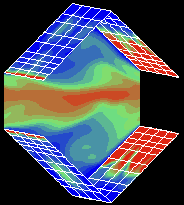

Miles Greiner
Dept. of Mechanical Engineering
University of Nevada, Reno, NV
Henry M. Tufo
Mathematics and Computer Science Division
Argonne National Laboratory, Argonne, IL
Van Ti Van
Dept. of Mechanical Engineering
University of Nevada, Reno, NV


These images show results from simulation of forced convection in a channel having transverse grooves. The V-shaped groove surfaces are held at a constant temperature while hot fluid passes through the channel, resulting in a net transfer of heat from the fluid to the walls. The Reynolds number is Re=1000, based on hydraulic diameter and mean flow rate. Periodic boundary conditions are used in the streamwise and spanwise directions. Time-varying temperature contours are shown on the backplane, and the heat flux distribution (local Nusselt number) is shown on the groove surfaces. The time-averaged temperature and heat flux distributions for this simulation are shown on the right.
The objective of this project is to study possible mechanisms for increasing heat transfer between the surface and the fluid at minimal pumping cost. Experimental evidence suggest that a groove-flat configuration, in which a sequence of grooves such as the one shown here are followed by a flat region, can yield significant increases in heat-transfer without undue increases in pumping power. To simulate the complete groove-flat configuration, we're investigating flows in flat channels which have as their inlet boundary condition the outflow of the fully developed grooved channel flow.
Pictured here are example of time-periodic temperature distribution
in a channel at Re=400. Without the unsteadiness induced by the grooves,
this flow would be completely steady, settling to the quiescent
state obseved at the channel exit. The lower image shows the developing
channel flow at two different Z-planes for a higher Reynolds number case.


Related Articles:
Last update: February 11, 1999 (pff)